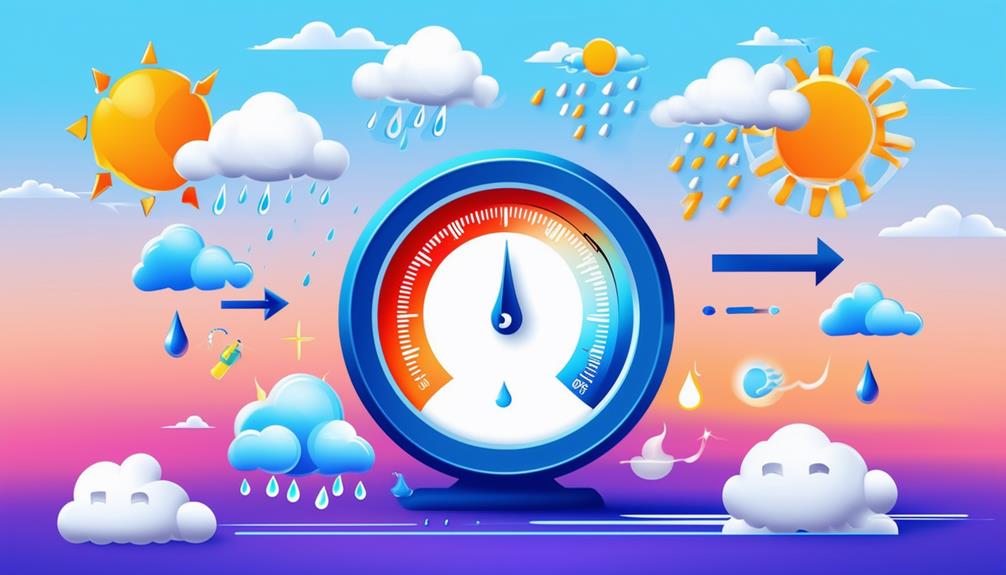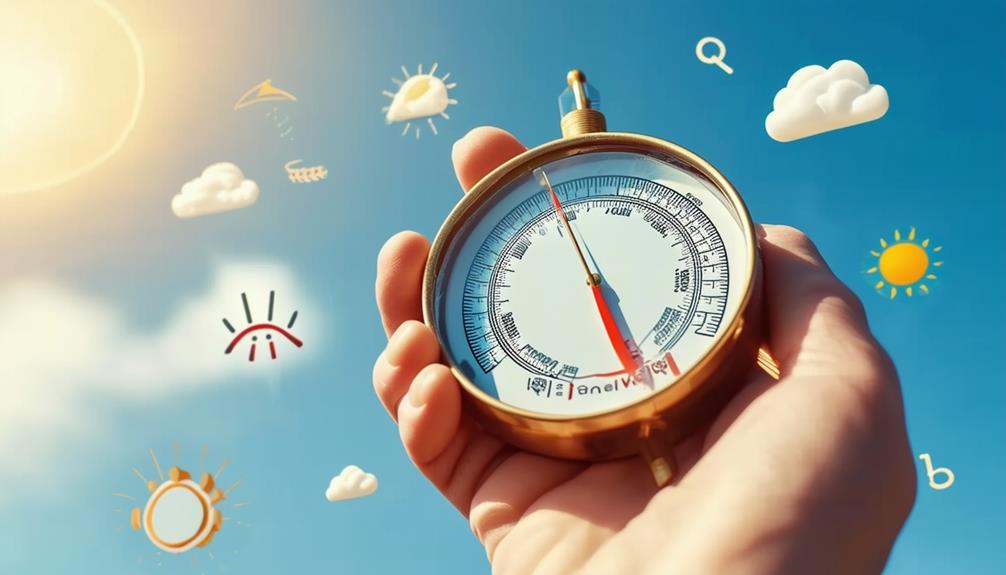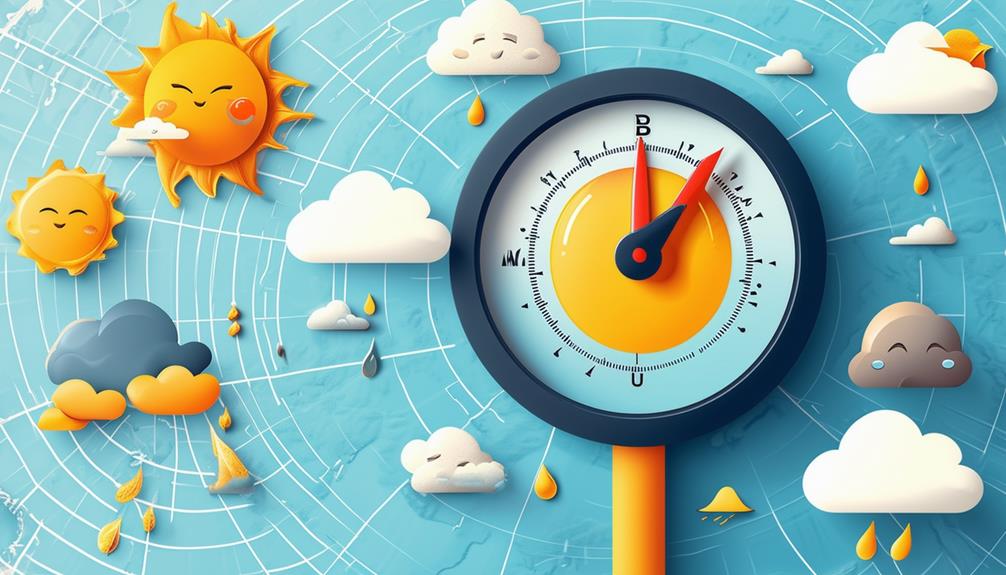How to Read and Understand Barometric Pressure

To effectively read and understand barometric pressure, familiarize yourself with key units of measurement such as inches of mercury, millibars, and hectopascals. High pressure typically indicates fair weather, while low pressure can signal storms. A rising barometer suggests improving conditions, whereas a falling barometer indicates deteriorating weather.
However, these concepts must be interpreted within the broader context of weather patterns for accurate forecasting. Understanding barometric pressure is crucial for reliable weather predictions.
Understanding Barometric Pressure
Barometric pressure measures the force exerted by the weight of air molecules on a specific location on Earth. This measurement is crucial for understanding atmospheric conditions. At sea level, the average barometric pressure is about 14.7 pounds per square inch (PSI). As you ascend to higher elevations, atmospheric pressure decreases because there are fewer air molecules above you.
Monitoring barometric pressure helps in predicting weather patterns. A drop in barometric pressure typically indicates that a storm or adverse weather is approaching, while an increase suggests clearer skies. These fluctuations are essential for meteorologists in weather forecasting.
Barometric pressure is dynamic and varies with elevation, location, and time. Changes in atmospheric pressure can significantly impact daily life, influencing weather conditions and even physical well-being. Understanding these changes aids in anticipating weather patterns and preparing accordingly.
Types of Barometers
There are various types of barometers available for measuring atmospheric pressure, each with its unique method and advantages.
Mercury barometers are among the oldest and most reliable instruments. They utilize a glass tube filled with mercury that rises or falls in response to changes in atmospheric pressure. These instruments are highly accurate but can be bulky and fragile.
Aneroid barometers don't use any liquid. Instead, they rely on a flexible metal box, known as an aneroid cell, which expands or contracts with pressure changes. These barometers are more portable and safer than their mercury counterparts.
Digital barometers represent the modern choice for many users. They employ electronic sensors to provide quick and precise barometric readings. Their ease of use and high accuracy make them popular among both professionals and enthusiasts.
Barographs are essential if you need to track pressure changes over time. They continuously record barometric pressure, either on paper or digitally, allowing for detailed analysis beneficial for weather forecasting.
For outdoor activities like hiking or sailing, portable barometers are indispensable. These compact devices are designed for easy pressure monitoring on the go, helping you stay informed about changing weather conditions.
Each type of barometer serves a specific purpose, so select the one that best meets your needs.
How to Measure Pressure

To measure barometric pressure, you can use various techniques and units. Traditional barometers utilize mercury columns, whereas modern devices often employ capacitive sensors. Pressure readings are typically presented in inches of mercury (inHg), millibars (mb), or hectopascals (hPa), which can be converted for standardization.
Barometric Measurement Techniques
Accurately measuring atmospheric pressure involves using tools such as mercury barometers, aneroid barometers, and digital barometers. A mercury barometer uses a glass tube filled with mercury to measure atmospheric pressure and is known for its high accuracy. However, it can be cumbersome and hazardous due to the toxic nature of mercury.
An aneroid barometer employs a small, flexible metal box called an aneroid cell. This cell expands and contracts with changes in atmospheric pressure, which is then translated into a readable measurement. Aneroid barometers are portable, easy to use, and mercury-free, making them a popular choice for many users.
Digital barometers enhance accuracy by using capacitive pressure sensors. These sensors detect pressure changes by measuring the capacitance between two surfaces, providing precise and instant readings. Digital barometers often feature data logging and connectivity options, making them versatile tools for modern weather forecasting.
Understanding the functionalities of mercury, aneroid, and digital barometers will help you choose the most suitable tool for your needs. Each type has unique advantages, so selecting the right one depends on your specific requirements.
Pressure Reading Units
When measuring barometric pressure, you'll often encounter units like inches of mercury (inHg), millibars (mb), pascals (Pa), or hectopascals (hPa). Each unit serves a specific purpose and is preferred in different contexts. The National Weather Service (NWS) primarily uses inches of mercury to report surface air pressure, making it straightforward for the general public to understand weather forecasts.
Scientists and meteorologists, however, prefer using hectopascals (hPa) because it is the standard international unit for atmospheric pressure. Traditional barometers used glass tubes filled with mercury to indicate pressure changes, whereas modern barometers employ advanced capacitive sensors for more accurate and reliable readings.
Here's a quick comparison of these units:
| Unit | Symbol | Common Use |
|---|---|---|
| Inches of Mercury | inHg | Weather reports by NWS |
| Millibars | mb | Older meteorological data |
| Pascals | Pa | Scientific research |
| Hectopascals | hPa | Standard meteorological unit |
Understanding these units helps you accurately measure and interpret barometric pressure, which is essential for predicting weather changes. Whether you're using a traditional barometer or a modern sensor, familiarity with these units will enhance your weather forecasting skills.
Interpreting Pressure Readings
When interpreting pressure readings, high pressure typically indicates fair weather, while low pressure often suggests stormy conditions. Understanding these trends can help you decide whether to bring an umbrella or sunglasses. Pressure readings are usually given in units like millibars or inches of mercury, so pay attention to these measurements.
High Vs. Low Pressure
Understanding how to interpret high and low barometric pressure readings can greatly enhance your ability to predict weather changes. High pressure typically brings clear skies, fair weather, and stable conditions, while low pressure is associated with cloudy skies, precipitation, and potentially stormy weather. Recognizing these pressure fluctuations helps you comprehend various weather conditions and the air masses involved.
High pressure systems generally result in cooler temperatures and light winds, whereas low pressure systems often lead to warmer and more humid conditions. Increasing barometric pressure indicates improving weather, while decreasing pressure suggests that weather conditions may worsen. This connection between high and low pressure is crucial for predicting the weather and planning outdoor activities effectively.
Here's a quick reference table to assist you in interpreting these pressure readings:
| Pressure Type | Weather Conditions | Typical Features |
|---|---|---|
| High Pressure | Clear skies, fair weather | Cooler temperatures, gentle winds |
| Low Pressure | Cloudy skies, precipitation | Warmer temperatures, increased humidity |
| Rising | Improving weather | Clearer skies, stable conditions |
| Falling | Deteriorating weather | Increased cloudiness, potential storms |
Weather Trends Indication
By interpreting barometric pressure readings, you can effectively forecast weather trends and prepare for changes in atmospheric conditions. Rising air pressure typically indicates improving weather, with clear skies and fair conditions. Conversely, falling barometric pressure suggests deteriorating weather, with an increased likelihood of storms or precipitation.
Sudden drops in barometric pressure are particularly significant, as they can signal the approach of severe weather events like thunderstorms or hurricanes. Understanding these trends helps you anticipate and prepare for major weather changes.
High-pressure systems are generally associated with stable, calm weather patterns. High barometric pressure readings often mean clearer skies and milder conditions. Conversely, low-pressure systems usually bring unsettled weather, with low barometric pressure readings indicating cloudy skies, rain, or storms.
Pressure Reading Units
Barometric pressure is measured in various units, including inches of mercury (inHg), millibars (mb), and hectopascals (hPa). Understanding these units is crucial for accurately interpreting pressure readings.
The National Weather Service typically reports surface air pressure in inHg, a practice rooted in the use of traditional mercury barometers. However, scientists and meteorologists prefer using hectopascals (hPa) for standardization.
When the barometer rises, it often indicates improving weather conditions. Here's how to interpret the units:
- Inches of mercury (inHg): Commonly used in the United States, 1 inHg is approximately equal to 33.86 hPa.
- Hectopascals (hPa): Standard in meteorology, 1 hPa is equivalent to 1 millibar.
- Millibars (mb): Essentially the same as hPa, these units are often used interchangeably.
Traditional mercury barometers measure pressure changes by observing the height of mercury in a glass column. Modern barometers, however, often use capacitive-based pressure transducers, providing more precise measurements. Understanding these units and the tools used to measure barometric pressure helps improve weather prediction accuracy.
Weather Prediction Techniques

It all starts at weather stations, where barometers measure atmospheric pressure. Barometers detect the pressure exerted by air molecules, and changes in this pressure can indicate different weather conditions. For instance, decreasing pressure often signals an approaching storm or rain. This data is plotted on weather maps, allowing forecasters to visualize pressure changes across large areas.
Rising barometric pressure usually indicates improving weather conditions, such as clear skies and calm winds. Conversely, falling barometric pressure suggests that clouds, precipitation, and potentially storms are on the way. Meteorologists closely monitor these trends, as a sudden drop in pressure can warn of severe weather events like thunderstorms or hurricanes.
Understanding barometric readings is crucial for predicting weather patterns. High pressure often correlates with fair weather, while low pressure is associated with rain. By connecting points of equal pressure with lines called isobars on weather maps, meteorologists can forecast weather changes across different regions. These techniques transform raw barometric data into actionable weather predictions, helping you prepare for whatever Mother Nature has in store.
Barometer Maintenance Tips
Maintaining your barometer properly ensures it provides the most accurate weather readings. Follow these essential maintenance tips to keep your barometer in optimal condition:
- Leveling: Ensure your barometer is always level. An uneven barometer can lead to incorrect pressure readings, affecting your weather predictions.
- Calibration: Regularly calibrate your barometer to maintain accuracy. Depending on the type, this may involve adjusting a screw or setting it against a known pressure value.
- Placement: Choose an appropriate location for your barometer. Avoid placing it near heat sources or drafts, as these can cause fluctuations in temperature and air movement, leading to inaccurate readings.
- Cleaning: Clean your barometer regularly. Dust and grime can obscure the readings, making it difficult to read the barometric pressure accurately. Use a soft cloth to gently wipe the surface without scratching it.
Additionally, if you have a mercury barometer, check for leaks or damage. Even a small leak can cause significant inaccuracies.
Significance in History

Understanding how to maintain your barometer is important, but it's equally fascinating to delve into its historical significance, which dates back to Evangelista Torricelli's groundbreaking invention in 1643. Torricelli's barometer was the first device to measure atmospheric pressure, fundamentally altering our comprehension of the natural world. This innovation demonstrated the existence of air pressure and laid the groundwork for modern meteorology.
Barometric pressure has been pivotal in scientific advancement. Early barometers were crucial for aviation and maritime navigation, providing vital data for safe travel. These instruments not only assisted explorers and scientists but also captivated the public imagination, prominently featuring in art and literature, thus underscoring their cultural impact.
Investigating the history of barometers reveals their influence across various fields. Their capacity to predict weather patterns made them indispensable tools for farmers and sailors, while their portrayal in cultural works highlights their broader significance.
Understanding barometric pressure extends beyond interpreting numbers; it involves appreciating a rich history that has shaped our interaction with the environment. This knowledge deepens your appreciation of both the scientific and cultural heritage surrounding barometers.
Conclusion
Understanding barometric pressure provides valuable insights into weather patterns. By using various types of barometers and learning how to measure and interpret pressure readings, you can more accurately predict weather changes.
Regular maintenance of your barometer ensures optimal performance. These skills not only enhance your ability to forecast the weather but also deepen your appreciation of the historical significance of barometric pressure in meteorology. Happy weather watching!




